PrAACtically Reading with Karen Natoci: Yo! Yes?
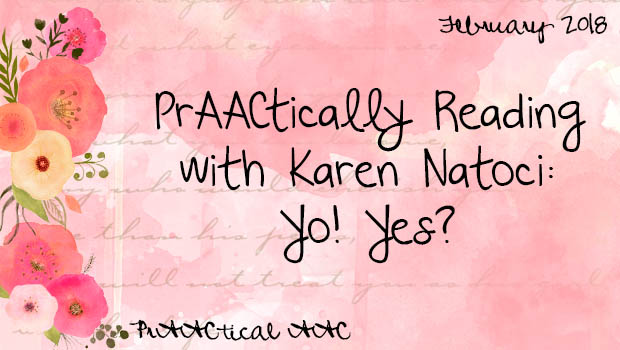
 Karen Natoci’s first book of the year is packed with fun and AAC potential. Karen is currently an AAC Supervisor with The Speech Pathology Group in Walnut Creek, California. Over the years, Karen has supported AAC learners in several capacities. You can see previous posts that Karen contributed here.
Karen Natoci’s first book of the year is packed with fun and AAC potential. Karen is currently an AAC Supervisor with The Speech Pathology Group in Walnut Creek, California. Over the years, Karen has supported AAC learners in several capacities. You can see previous posts that Karen contributed here.
Today, she talks about ways to build language and communication in this flexible book. Enjoy!
:::::::::::::::::::::::::::::::::::::::::::::::::::::::::::::::::::::::::::::::::::::::::
Book: Yo! Yes? By Chris Raschka (Orchard Books, Scholastic, Inc. New York)
It’s February, the beginning of the second half of the school year. Let’s make a new friend! This beautiful book was first shared during the Literacy Intensive Course with coached by the wonderful Karen Erickson and David Koppenhaver in Michigan. It is a book with few words but with much emotion. Here are some ways to use this book in your classroom.
- You can read this as is by using core words exclusively
- It offers the opportunity to practicing the “marking” of intonation, which can be a unique challenge for those who communicate using AAC systems (such as emphasizing a word by repeating it, emphasize through body language, facial expressions, vocalizations, or by explicitly stating what their intonation would be such as: “I am shouting now even
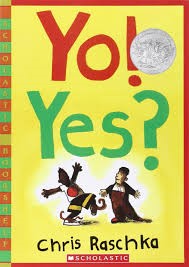 though my talker doesn’t sound like I am!”)
though my talker doesn’t sound like I am!”) - This minimal word book may offer a chance for learners to expand on the minimal dialogue using speech bubbles and create more lines for the characters in the book (see printable speech bubbles below)
- Opportunity to act out the book and practice the power of body language: imitate the characters and add your own body language
- Rehearse multiple options of intonation – what intonation matches the intent of the character and text and why? For example, on page two, “Yes?” can be read with a rising intonation in a manner that would be: suspicious, enthused, annoyed, innocent but only one or two of these options match the body language in the illustration. This offers a wonderful opportunity to discuss pragmatic features of communication!
- Discuss feelings depicted on the pages, compare with real experiences
- What would YOU say if you wanted to make a new friend? Students can think of what they would say and these messages can be programmed into their “quick chats” pages.
Competency Areas:
Linguistic: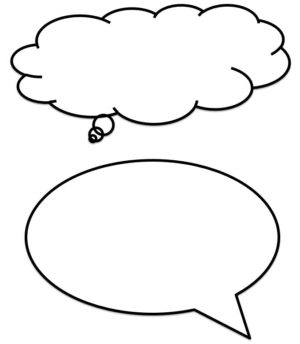
Core Vocabulary Focus: I, you, hey, yes, no, what? Me, who? Go, oh? Do, here, come, go, Oh! Like,
Fringe Vocabulary Focus: friend, talk, sit, play, hang out,
Expand MLU: add more words, create short sentences,
Overt, purposeful expression of intent: I am asking a question, I am stating a comment, I am saying this with excitement, I am expressing this in a surprised way,
Strategic/Social:
Pragmatic: Use affective, body language to clarify intent of message
Book Reading Activity:
FIRST Read: Always begin with an enthused, basic reading of the book. Announce the title, author, share the book cover with everyone.
Subsequent Reads: Ask if anyone would like to volunteer to act it out! The language can easily be programmed into their sequencers (or step by steps) and suitable phrases may be improvised, too! Talk about body language and practice the art of self-expression using one’s personal means to do so.
Other wordless picture books:
- The Snowman by Raymond Briggs
- A Ball for Daisy by Chris Raschka
- Beaver Is Lost by Elisha Cooper
- Time Flies by Eric Rohmann
- Mine! By Shutta Crum
You can download Karen’s talk and thought bubbles use with this book here.
Filed under: Featured Posts, PrAACtical Thinking
Tagged With: Karen Natoci, reading
This post was written by Carole Zangari


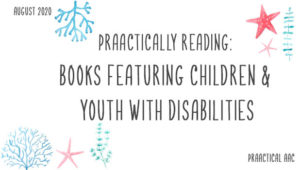

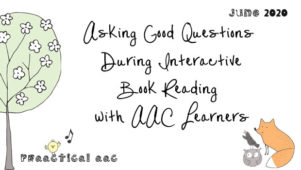
1 Comment
I want to add a link to this wonderful site (Scholastic) listing wordless books!
https://www.scholastic.com/parents/books-and-reading/raise-a-reader-blog/wordless-picture-books-must-reads-older-readers.html